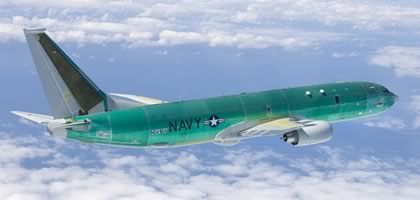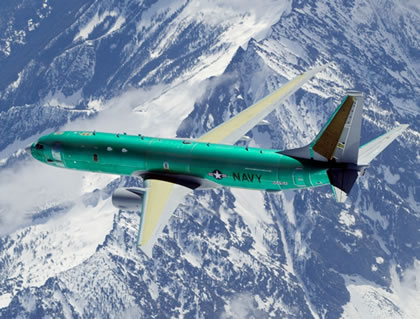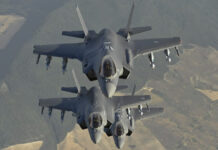Boeing is modifying its single-isle flagship – Boeing-737-800 airframe into a fighting machine. The first fuselage was completed by Spirit Aerospace and moved by rail from Wichita, Kansas to Renton, Washington, where the first B-737-800 is transformed into the P-8A Poseidon multi-mission maritime aircraft (MMA), a future successor of the venerable P-3 Orion. As it enters service in 2013 Poseidon will be the world’s most advanced long-range maritime patrol and reconnaissance aircraft. At least two spiral evolutions are planned through the program, in 2015 and 2017.
Boeing was awarded the $3.89 billion system development and demonstration (SDD) phase contract for the Poseidon program in 2004. The P-8A is being developed for the U.S. Navy by a Boeing-led industry team that consists of CFM International, Northrop Grumman, Raytheon, Spirit AeroSystems and GE Aviation.
The program includes 114 aircraft, including three flight-test aircraft (plus two airframes for static tests), and tree production representative test aircraft, in addition to 108 serial production planes slated to replace the currently operational fleet of P-3C aircraft. Initial operational capability for the U.S. Navy is planned for 2013. In 2013-2014 time frame the Indian Navy is also scheduled to receive the initial deliveries of the eight P-8I ordered in 2008. The Indian Poseidons will be customized to the Indian requirements, and will be slightly different than the P-8A the U.S. and Australian Navies.
Poseidon is designed for maximum takeoff gross weight of 187,000 lbs (85.139 tons). It will be powered by two CFM56-7B engines developing 27,300 lbs of thrust each, accelerating the aircraft to 490 knots (564 mph). It will have a ceiling of 41,000 ft and 1,200 nmi range, carrying enough fuel on board to sustain four hours on station flying at different levels according to the mission requirements. The plane accommodates a crew of 9. Crew workstations will accommodate a common design, employing dual ultra-high resolution 24″ color displays, showing multiple layers with variable transparency building a tactical mission display from maps, images and tactical overlays. Each operator can create display filters to select specific data and overlays suitable for his specific mission and area of interest.
Poseidon will carry the AN/APY-10 radar, developed by Raytheon specifically for the aircraft, supporting maritime, littoral, and overland mission capabilities. The multimode system supports Synthetic aperture radar mode (SAR) Inverse SAR (ISAR) operating modes, surface search and periscope detection with Track-while-scan capability, navigation, weather modes. APY-10 is a derivative of Raytheon’s APS-137 radar.
The acoustic processing system processes sound signals received from dropped sonobuoys, the increased processing capacity available for the Poseidon will enable the crew to employ auto-detection algorithms.
The aircraft will be fitted wit Electronic Support Measures (ESM) based on an array of fixed interferometer antennae and another antenna array mounted on a spinning pedestal. The ESM system developed by Northrop Grumman provides rapidly updated situational picture, electronic intelligence and rapid geo-location of targets which could be further investigated by other sensors, such as radar and EO payloads. Northrop Grumman will provide the EO payload for the system. The aircraft has an extensive array of self-defense systems to counter heat-seeking surface-to-air missiles. It employs a towed self-protection decoy and a directional infrared self-protection system (DIRCM), coupled with missile approach warning (MAW), chaff and flare dispensing systems. The aircraft has four underwing hardpoints to carry external stores, including Harpoon anti-ship missiles, and SLAM-ER guided weapons. More weapons, including torpedoes and depth charges can be stored in the weapons bay.
While the P-8A is designed to meet the U.S. Navy requirements, the aircraft is well positioned to replace P-3 aircraft currently operating with international navies and air forces. These include Canada, Brazil, Chile and Argentina, in North and South America, Norway, Germany, Spain, U.K., Italy, Portugal and Greece in Europe, Australia and New Zealand in Oceania, Japan, South Korea, Taiwan, Thailand, Pakistan and India in Asia. In fact, Boeing has already submitted an offer to deliver the aircraft to the Indian Navy, replacing aging Il-38 based ASW aircraft.
A derivative of the Boeing 737-800 Poseidon is currently under concept refinement, as part of a $1.25 million contract awarded to Boeing and SIGINT specialist Argon ST, to help define program requirements and develop initial system concepts for the future multi-intelligence platform for the U.S. Navy, also known as ‘EPX’. The system will use the Poseidon platform, tailored for airborne SIGINT applications and multi-level security requirements. Employing advanced operator-machine interface techniques and automated information fusion, the EPX crew will be able to sense across a broad spectrum, rapidly analyze and isolate information and rapidly distribute key intelligence attributes to both strategic and tactical users. In July 2008 Boeing added Raytheon to its EP-X team, to be responsible for EP-X sensor integration and multi-intelligence integration and play a significant role in core mission systems. Raytheon is also a member of Boeing’s P-8A Poseidon industry team.

By July 2009 the navy and Boeing formally rolled out the first P-8A aircraft. All five test aircraft are in various stages of assembly and ground test; two of the flight test aircraft have already successfully flown as part of a Boeing relocation and system flight check process. Testing on the static loads airframe is underway and the Navy will begin formal flight testing later in 2009.
In April 2009 the Australian Department of Defence signed an agreement with the U.S. Department of Defense to join a cooperative partnership in the development of follow-on capabilities to be added to the Poseidon after it enters the fleet in 2013.
Read more on the Boeing 737-700 AEW&C platform
Read more about Special Mission Aircrafts:
- Special Missions Aircraft at Farnborough 2008
- G550 AEW Unveiled
- Saab Debut ‘2000 Special Mission Aircraft
- Boeing P-8A Poseidon Special Missions Aircraft
- Boeing 737-700 Based Early Warning & Control Aircraft






















